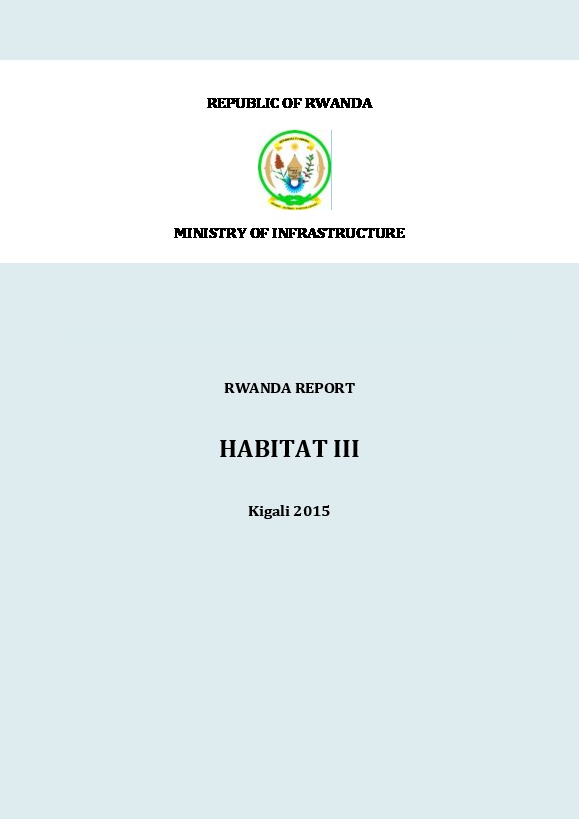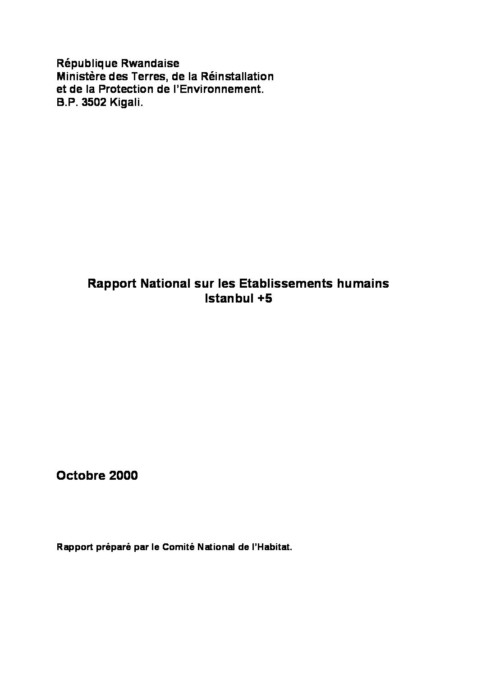
Rwanda
Urban indicators:
| Value | Year | ||
| Surface area (sq km) | 26338 | 2014 | |
| Population (proj., 000) | 11883 | 2016 | |
| Pop. density (per sq km) | 481.7 | 2016 | |
| Capital city | Kigali | 2015 | |
| Capital city pop. (000) | 1257 | 2015 | |
| Population growth rate (average annual %) | 2.4 | 2010-2015 | |
| Urban population growth rate (average annual %) | 6.4 | 2010-2015 | |
| CO2 emission estimates (000 tons/tons per capita) | 799/0.1 | 2013 | |
| Population using improved drinking water sources (urban/rural, %) | 86.6/71.9 | 2015 | |
| Population using improved sanitation facilities (urban/rural, %) | 58.5/62.9 | 2015 |
| 1995 | 2005 | 2014/2015 | |
| Urban population ('000) | 557 | 1,818 | 3,581 |
| Level of urbanization (%) | 9.8 | 19.3 | 28.8 |
| Proportion of urban population living in slum areas (%) | 87.9 | 71.6 | 53.2 |
| Urban Slum Population ('000) | 397 | 1,129 | 1,792 |
| Value | Year | |
| Urban poverty headcount ratio based on national poverty lines | 22.1% | 2010 |
National Report:
National Report Executive Summary:
Rwanda has made great strides on almost all development indicators in the last two decades. The country’s Vision 2020 has guided national development strategies toward five broad targets: rapid economic growth to middle income status, increased poverty reduction, more off-farm jobs and urbanization, reduced external dependency, and private sector as the engine of growth. The National Economic Development and Poverty Reduction Strategy, EDPRS2, has the overarching goal to accelerate progress toward a middle income status and better quality of life for all Rwandans. It focuses on four thematic areas: Economic transformation, Rural development, Productivity and Youth Employment, and Accountable governance.
The list of positive developments in Rwanda over the last 10 years includes a growth of GDP of 8% on average, growth in exports at 500% and imports at 300%, and the S & P Country Credit Rating being B with a positive outlook. Rwanda was ranked Africa‟’ most efficient Government in the 2014-2015 Global Competitive Report and the 2nd most competitive place to do business in Africa after Mauritius and positioned 62nd out of 189 countries in the World Bank Doing Business 2016. Such achievements can be attributed to the strong political will driving these positive changes.
Having embraced urbanization as a key priority area in the national development strategies including Vision 2020, the country highly considers the urban development agenda as a possible resource to unlock the transformative economic opportunities for growth and poverty reduction. Rwanda’s national overarching goal of 35% urbanisation rate by 2020 from 16.5% (Census, 2012) is driven by the strong political will to undertake significant investments in infrastructure, services and skills development. Under EDPRS2, six secondary cities were identified as economic poles of growth to promote investment in priority sectors, off- farm job creation and a green economy approach driven by private sector.
Appropriate policies, legal and institutional frameworks for housing and urban development have been established to foster a network of human settlements.
Urbanization and human settlements are guided by the Urbanization and Rural Sector Strategic Plan 2013-18. The strategy develops the objectives of good development management and of spatial distribution of growth, and translates them into two high level priorities:
To develop the basis for good urban and rural settlement management cross-cutting all development sectors and following clear guidelines and procedures at all levels of governance;
To create a hierarchical network of urban and urbanizing centers providing services and attracting economic activities countrywide, and to support the development of secondary cities, districts, towns and villages, as well as the capital, Kigali. Rwanda has also adopted a National Urbanisation Policy formulated with the highest level of stakeholder inclusion. Performance targets have been identified and implementation is being tracked. Each district has begun articulating its district level vision, local economic development strategy, district development plan, and detailed performance targets. The harmonious collaboration between all development sectors and actors shall lead to their achievement. Despite the above achievements and current initiatives, the success cannot be without challenges and lessons learnt to provide a guiding agreement for the new urban agenda. This report puts on record the achievements in the sector while highlighting challenges, lessons learnt and emerging issues to be addressed globally during the coming two decades. The data and analysis are based on document review, data from various government institutions, field visits, surveys and interviews with private, public and civil society leaders.
Emerging from this report as future challenges and issues for consideration in the new urban agenda are highlighted the following, but are not limited to:
Urban Demography
a) Support local governments in their capacity to identify the opportunities and constraints for poverty reduction and economic development provided by rural-urban linkages.
b) Pay attention to social safety programs for elderly who are likely to not have benefitted from just establishing social security programs and life-long schemes.
c) Help create attractive family-friendly conditions in urban areas.
Land and Urban Planning
a) Base public investment on evidenced resource efficient and effective spatial growth models, and integrate investment decisions about emerging centers, which usually pose a challenge to local governments.
b) Ensure integrated planning to be supported by modern technologies, which requires diverse skills. Application areas are planning, implementation and monitoring for integrated infrastructure systems.
c) Ensure sustainable linkage between environmental protection and agricultural production.
Environment and Urbanisation
a) Properly and in “green” manner manage the demand for increased industry and services establishment.
b) Emphasize on measures to improve traffic safety, including safety for pedestrians and cyclists.
c) Reduce the impact of disasters on vulnerable communities by integrating mitigation measures from planning trough project implementation.
Urban Governance and Legislation
a) Emphasize on the need to collaborate with civil society based organizations, to achieve and sustain policies and legislations which are inclusive and participatory despite development pressure and shortage of resources, and to maintain social cohesion and conviviality with inbuilt early dispute management.
b) Mitigate social life in Sub-Saharan African cities which is at risk of erosion of family and other social relations.
c) Adopt cross-sectoral approaches to policy development and program design for completeness, comprehensiveness, harmony and sustainability, and to embed addressing of human rights across the sector priorities.
Urban Economy
a) Intensify collaboration between National governments, finance sector and civil society when setting up housing programs, with the objective to carry financing risks collectively and to integrate population groups with low and irregular incomes.
b) Improve investment environments, resolve administrative bottlenecks, enhance customer orientation and emphasize on economic feasibility.
c) Focus on creating opportunities for the population currently active in the farming or informal sector, and for the students to find a good job when graduating.
Housing and Basic Services
a) While striving toward higher quantities of housing units produced, ensure high-quality, likeability and cultural identity in housing neighborhood design, as well as raise quality and skill levels in design, engineering and construction.
b) Facilitate collaborative schemes that bundle capacities as a vehicle to overcome shortage of finance and other resources in housing development, urban upgrading, and commercial development.
c) Ensure access to safe water, intensify measures to prevent water contamination in the ground and during transmission, and reduce the use of polluting sources of energy.
d) Improve public transport in support of adequate mass mobility, to make better use of urban space, reduce the dependence on more polluting modes of transport, and to enhance affordable means of transport for urban residents.
Statistics:
Urban housing indicators
People living in slums (%)
Urban population with access to adequate housing (%)
Basic services and infrastructure
Urban population with access to safe drinking water (%)
Urban population with access to adequate sanitation (%)
Urban population with access to regular waste collection (%)
Urban population with access to clean domestic energy (%)
Urban population with access to public transport (%)
Level of effective decentralization
Policies and legislation on urban issues that local governments contributed to formulating since 1996 (%)
Share of both income and expenditure allocated to local governments from the national budget (%)
Indicators for urban policies, legislation and economy
Local authorities having implemented urban policies supportive of local economic development and creation of decent jobs and livelihoods (%)
Local authorities having implemented plans and designs that are inclusive and respond to urban population growth adequately (%)
Statements by other countries on behalf of African Group and G77 and China:
-
Habitat III Plenaries
-
Intersessionals: Informal Intergovernmental Meetings (May 2016)
- Statement - 18 May (by Thailand) - English Made by Thailand on Behalf of G77 and China
- Statement – 18 May (by Nigeria, 1) - English Made by Nigeria on Behalf of African Group
- Statement - 18 May (by Jamaica) - English Made by Jamaica on Behalf of G77 and China
- Statement – 18 May (by Nigeria, 2) - English Made by Nigeria on Behalf of African Group
- Statement - 19 May (by Jamaica) - English Made by Jamaica on Behalf of G77 and China
- Statement – 19 May (by Nigeria, 1) - English Made by Nigeria on Behalf of African Group
- Statement - 19 May (by Kenya) - English Made by Kenya on Behalf of G77 and China
- Statement – 19 May (by Nigeria, 2) - English Made by Nigeria on Behalf of African Group
- Statement - 20 May (by Jamaica) - English Made by Jamaica on Behalf of G77 and China
- Statement – 20 May (by Nigeria, 1) - English Made by Nigeria on Behalf of African Group
- Statement - 20 May (by Thailand) - English Made by Thailand on Behalf of G77 and China
- Statement – 20 May (by Nigeria, 2) - English Made by Nigeria on Behalf of African Group


